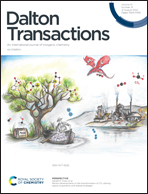Water soluble transition metal [Ni(ii), Cu(ii) and Zn(ii)] complexes of N-phthaloylglycinate bis(1,2-diaminocyclohexane). DNA binding, pBR322 cleavage and cytotoxicity†
Abstract
To validate the effect of metal ions in analogous ligand scaffolds on DNA binding and cytotoxic response, we have synthesized a series of water-soluble ionic N-phthaloylglycinate conjugated bis(diaminocyclohexane)M2+ complexes where M = Ni(II), Cu(II) and Zn(II) (1–3). The structural characterization of the complexes (1–3) was achieved by spectroscopic {FT-IR, EPR, UV–vis absorption data, 1H NMR, ESI-MS and elemental analysis} and single crystal X-ray diffraction studies, which revealed different topologies for the late 3d-transition metals. The Ni(II) and Zn(II) complexes exhibited an octahedral geometry with coordinated labile water molecules in the P![[1 with combining macron]](https://www.rsc.org/images/entities/char_0031_0304.gif) space group while the Cu(II) complex revealed a square planar geometry with the P21/c space lattice. In vitro DNA-complexation studies were performed employing various complementary biophysical methods to quantify the intrinsic binding constant Kb and Ksv values and to envisage the binding modes and binding affinity of (1–3) at the therapeutic targets. The corroborative results of these experiments revealed a substantial geometric and electronic effect of (1–3) on DNA binding and the following inferences were observed, (i) high Kb and Ksv values, (ii) remarkable cleavage efficiency via an oxidative pathway, (iii) condensation behavior and (iv) good cytotoxic response to HepG2 and PTEN-caP8 cancer cell lines, with copper(II) complex 2 outperforming the other two complexes as a most promising anticancer drug candidate. Copper(II) complexes have been proven in the literature to be good anticancer drug entities, displaying inhibition of uncontrolled-cell growth by multiple pathways viz., anti-angiogenesis, inducing apoptosis and reactive oxygen species mediated cell death phenomena. Nickel(II) and zinc(II) ionic complexes 1 and 3 have also demonstrated good chemotherapeutic potential in vitro and the bioactive 1,2-diaminocyclohexane fragment in these complexes plays an instrumental role in anticancer activity.
space group while the Cu(II) complex revealed a square planar geometry with the P21/c space lattice. In vitro DNA-complexation studies were performed employing various complementary biophysical methods to quantify the intrinsic binding constant Kb and Ksv values and to envisage the binding modes and binding affinity of (1–3) at the therapeutic targets. The corroborative results of these experiments revealed a substantial geometric and electronic effect of (1–3) on DNA binding and the following inferences were observed, (i) high Kb and Ksv values, (ii) remarkable cleavage efficiency via an oxidative pathway, (iii) condensation behavior and (iv) good cytotoxic response to HepG2 and PTEN-caP8 cancer cell lines, with copper(II) complex 2 outperforming the other two complexes as a most promising anticancer drug candidate. Copper(II) complexes have been proven in the literature to be good anticancer drug entities, displaying inhibition of uncontrolled-cell growth by multiple pathways viz., anti-angiogenesis, inducing apoptosis and reactive oxygen species mediated cell death phenomena. Nickel(II) and zinc(II) ionic complexes 1 and 3 have also demonstrated good chemotherapeutic potential in vitro and the bioactive 1,2-diaminocyclohexane fragment in these complexes plays an instrumental role in anticancer activity.
![Graphical abstract: Water soluble transition metal [Ni(ii), Cu(ii) and Zn(ii)] complexes of N-phthaloylglycinate bis(1,2-diaminocyclohexane). DNA binding, pBR322 cleavage and cytotoxicity](/en/Image/Get?imageInfo.ImageType=GA&imageInfo.ImageIdentifier.ManuscriptID=D2DT01312F&imageInfo.ImageIdentifier.Year=2022)


 Please wait while we load your content...
Please wait while we load your content...